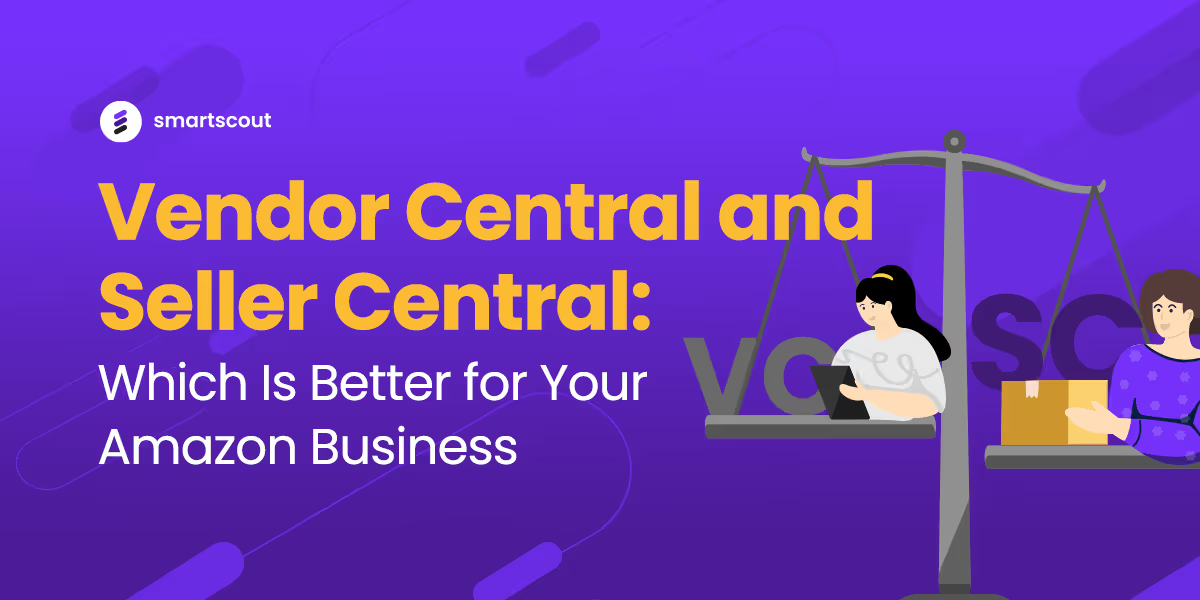As the Amazon Marketplace grows, businesses face the critical decision of choosing between Vendor Central and Seller Central to sell their products.
Let's explore the key differences between these platforms — focusing on price controls, margin controls, and other vital aspects influencing a business's success on Amazon. By understanding these differences, businesses can make more informed decisions and have an optimized Amazon strategy.
Vendor Central vs. Seller Central: A Brief Overview
Vendor Central is an exclusive, invite-only platform where businesses sell their products wholesale to Amazon, which then becomes the seller of record. This approach simplifies several aspects of the selling process but also limits the control businesses have over pricing and inventory.
Seller Central, on the other hand, allows businesses to sell their products directly to customers as third-party sellers. While this approach offers more control over pricing and inventory, it also involves more responsibilities, such as managing the entire sales channel and increasing Fulfillment by Amazon (FBA) fees.
Price and Margin Controls: Vendor Central vs. Seller Central
In Vendor Central, Amazon has more control over product pricing, which can be both an advantage and a disadvantage. While Amazon's pricing algorithm can maximize sales, it might also lead to frustration as you can’t predict what will happen. If you have a pricing strategy across all your sales channels, Amazon might price lower creating some market confusion.
Seller Central provides businesses with greater control over pricing and margins. Sellers can set their desired prices and adjust them as needed. However, this increased control comes with managing the pricing strategy to stay competitive and profitable. It’s anything but set it and forget it.
Responsiveness of Vendor Managers
One challenge faced by businesses using Vendor Central is the lack of responsiveness from vendor managers. Since Amazon assigns a vendor manager to handle your account, your success may depend on their level of engagement and responsiveness. A non-responsive vendor manager can significantly hinder a business's ability to address issues, negotiate deals, or make necessary changes.
Increasing FBA Fees for Seller Central
Seller Central users who utilize FBA face the challenge of increasing fees. Over the years, Amazon has raised FBA fees, storage fees, and other charges, which can impact profit margins for sellers. Businesses using Seller Central must carefully consider these costs and weigh them against the benefits of using FBA. FBA is basically required to get the Prime badge. If you have inventory that doesn’t sell through as you hoped, you’re going to be paying more and more.
The Exclusive Nature of Vendor Central
As an invite-only platform, Vendor Central is exclusive and not accessible to all businesses. This exclusivity can make it difficult for smaller businesses or new brands to take advantage of the benefits offered by Vendor Central. In recent years, Amazon has stopped extending invites at time. So the decision may be dead on arrival. But if you have an invite and you’re still considering your options, read on.
Managing the Channel on Seller Central
Managing every aspect of the sales channel on Seller Central can be challenging and time-consuming. From inventory management and pricing strategy to customer service and order fulfillment, businesses using Seller Central must have the resources and expertise to handle these tasks effectively. It’s more of a hands-on approach. Vendor Central still can require effort, especially to scale it effectively.
Hybrid Approach: Combining Vendor Central and Seller Central
Some brands use both Vendor Central and Seller Central to maximize their Amazon presence. This hybrid approach allows businesses to leverage the benefits of each platform while mitigating some of their drawbacks.
For example, a brand may sell its best-selling products through Vendor Central while utilizing Seller Central for niche or specialty items, allowing for more control over pricing and inventory.
This may not always work. Sometimes Vendor Manager for certain categories will prohibit brands from selling directly. This has led to brands using wholesale exclusive relationships to bypass this. Certainly, it’s not ideal to bring in more players to the decision table as it can complicate the finances. But there can be an upside. Companies such as ReCommerce and Pattern have succeeded in this route in helping brands go direct.
Conclusion
Choosing between Vendor Central and Seller Central is critical for businesses selling on the Amazon Marketplace. Businesses can determine which platform best suits their needs by carefully considering factors such as price and margin controls, vendor manager responsiveness, FBA fees, platform exclusivity, and channel management.
Adopting a hybrid approach that combines the strengths of both platforms may be the most effective strategy for maximizing success on Amazon.










